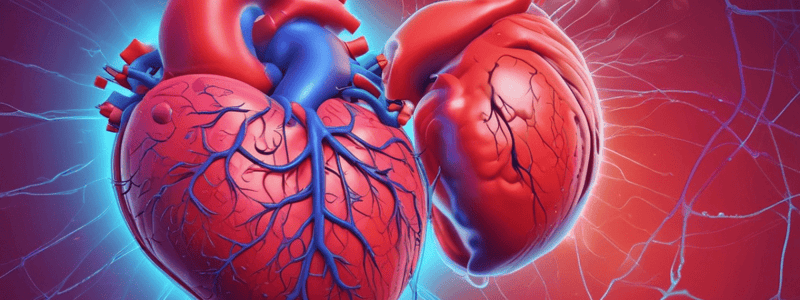Podcast
Questions and Answers
La clasificación NYHA se centra en los síntomas relacionados con la disfunción diastólica del corazón.
La clasificación NYHA se centra en los síntomas relacionados con la disfunción diastólica del corazón.
False (B)
La insuficiencia cardíaca diastólica es conocida como la 'insuficiencia cardíaca activa'.
La insuficiencia cardíaca diastólica es conocida como la 'insuficiencia cardíaca activa'.
False (B)
Los pacientes con insuficiencia cardíaca diastólica pueden no mostrar síntomas notables a pesar de un llenado ventricular derecho reducido.
Los pacientes con insuficiencia cardíaca diastólica pueden no mostrar síntomas notables a pesar de un llenado ventricular derecho reducido.
False (B)
La insuficiencia cardíaca crónica se caracteriza por la acumulación de líquido en los riñones, fatiga y dolor de cabeza.
La insuficiencia cardíaca crónica se caracteriza por la acumulación de líquido en los riñones, fatiga y dolor de cabeza.
La disnea al hacer esfuerzo es uno de los síntomas comunes de la insuficiencia cardíaca crónica.
La disnea al hacer esfuerzo es uno de los síntomas comunes de la insuficiencia cardíaca crónica.
La clasificación funcional de la Asociación del Corazón de Nueva York (NYHA) categoriza a los pacientes con insuficiencia cardíaca en tres clases diferentes.
La clasificación funcional de la Asociación del Corazón de Nueva York (NYHA) categoriza a los pacientes con insuficiencia cardíaca en tres clases diferentes.
La Clase II de la clasificación de la NYHA indica que los pacientes tienen una limitación marcada en la actividad física.
La Clase II de la clasificación de la NYHA indica que los pacientes tienen una limitación marcada en la actividad física.
La insuficiencia cardíaca diastólica se produce cuando el músculo cardíaco se vuelve más flexible con el tiempo.
La insuficiencia cardíaca diastólica se produce cuando el músculo cardíaco se vuelve más flexible con el tiempo.
En la insuficiencia cardíaca sistólica, el corazón no puede bombear suficiente sangre para satisfacer las necesidades del cuerpo.
En la insuficiencia cardíaca sistólica, el corazón no puede bombear suficiente sangre para satisfacer las necesidades del cuerpo.
La insuficiencia cardíaca aguda se presenta cuando el corazón no muestra ningún síntoma incluso durante el reposo.
La insuficiencia cardíaca aguda se presenta cuando el corazón no muestra ningún síntoma incluso durante el reposo.
Flashcards are hidden until you start studying
Study Notes
Heart Failure Classification by NYHA Chronology
The New York Heart Association (NYHA) functional classification is a widely used method for categorizing patients with heart failure. First proposed in 1928 and later revised in 1994, the NYHA system categorizes patients into four classes based on limitations of physical activity. These classes help assess the functional impact of heart failure on a patient's daily life and guide treatment strategies.
NYHA Classification
The NYHA classification consists of four classes:
- Class I: No limitations of physical activity. Ordinary physical activity does not cause undue fatigue, palpitation, dyspnoea (shortness of breath), or anginal pain.
- Class II: Slight limitation of physical activity. Comfortable at rest. Ordinary physical activity results in fatigue, palpitation, dyspnoea, or anginal pain.
- Class III: Marked limitation of physical activity. Comfortable at rest. Less than ordinary physical activity causes fatigue, palpitation, dyspnoea, or anginal pain.
- Class IV: Symptoms of heart failure at rest. Any physical activity causes further discomfort.
Diastolic Heart Failure
Diastolic heart failure occurs when the heart muscle becomes stiffer over time, making it difficult for the left ventricle to fill properly with blood. As a result, the heart doesn't pump enough blood to meet the body's needs. While the NYHA classification focuses on symptoms related to reduced pump function (systolic heart failure), diastolic heart failure is considered the "silent heart failure," as patients may not exhibit noticeable symptoms despite reduced left ventricular filling.
Chronic Heart Failure
Chronic heart failure is a condition characterized by the progressive decline of the heart's ability to pump blood effectively. Over time, this leads to fluid accumulation in the lungs, swelling, and fatigue. Chronic heart failure patients commonly experience symptoms such as dyspnea upon exertion, orthopnoea (shortness of breath while lying down), paroxysmal nocturnal dyspnoea (waking up at night due to shortness of breath), and peripheral oedema (swollen legs and feet). NYHA class III–IV symptoms are considered early signs of chronic heart failure, as they indicate an increasing severity of symptoms.
Acute Heart Failure
Acute heart failure occurs suddenly and is marked by significant fluid retention leading to lung and peripheral vascular congestion. Symptoms of acute heart failure can be severe and life-threatening, including dyspnoea, hypotension, cyanosis, and cardiogenic shock (low circulating blood volume due to the heart's failure to pump properly). While progression to chronic heart failure is possible, acute heart failure frequently responds well to initial medical intervention, such as intravenous vasodilatory agents, loop diuretics, oxygen therapy, and mechanical support devices.
NYHA Classification and Heart Failure Outcomes
Studies have shown that higher NYHA classes are associated with poor outcomes in heart failure patients, such as increased mortality and hospitalizations due to all causes. In one study, NYHA class III–IV patients had nearly twice the rate of mortality compared to class I–II patients during follow-up. It is crucial for healthcare professionals to monitor and manage patient symptoms according to their assigned NYHA class to optimize treatment strategies and improve overall prognosis.
Studying That Suits You
Use AI to generate personalized quizzes and flashcards to suit your learning preferences.




